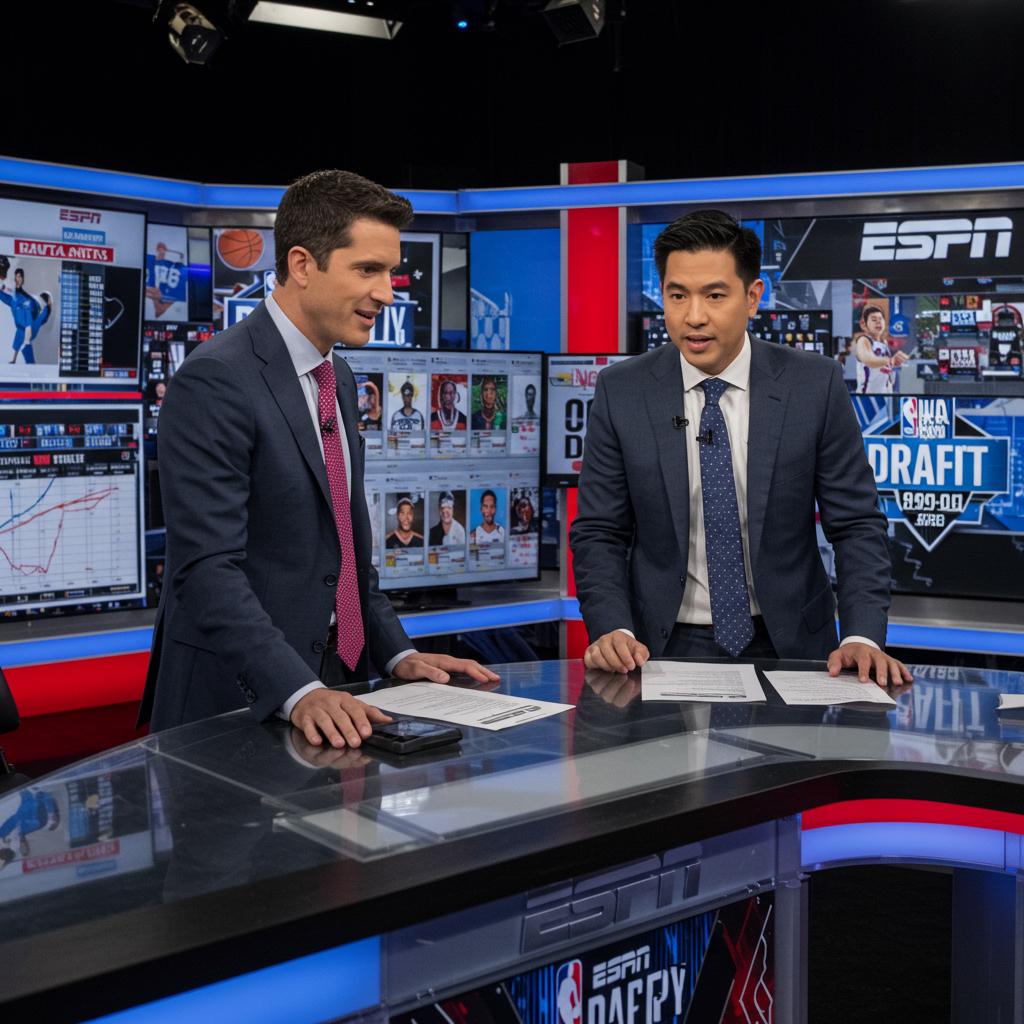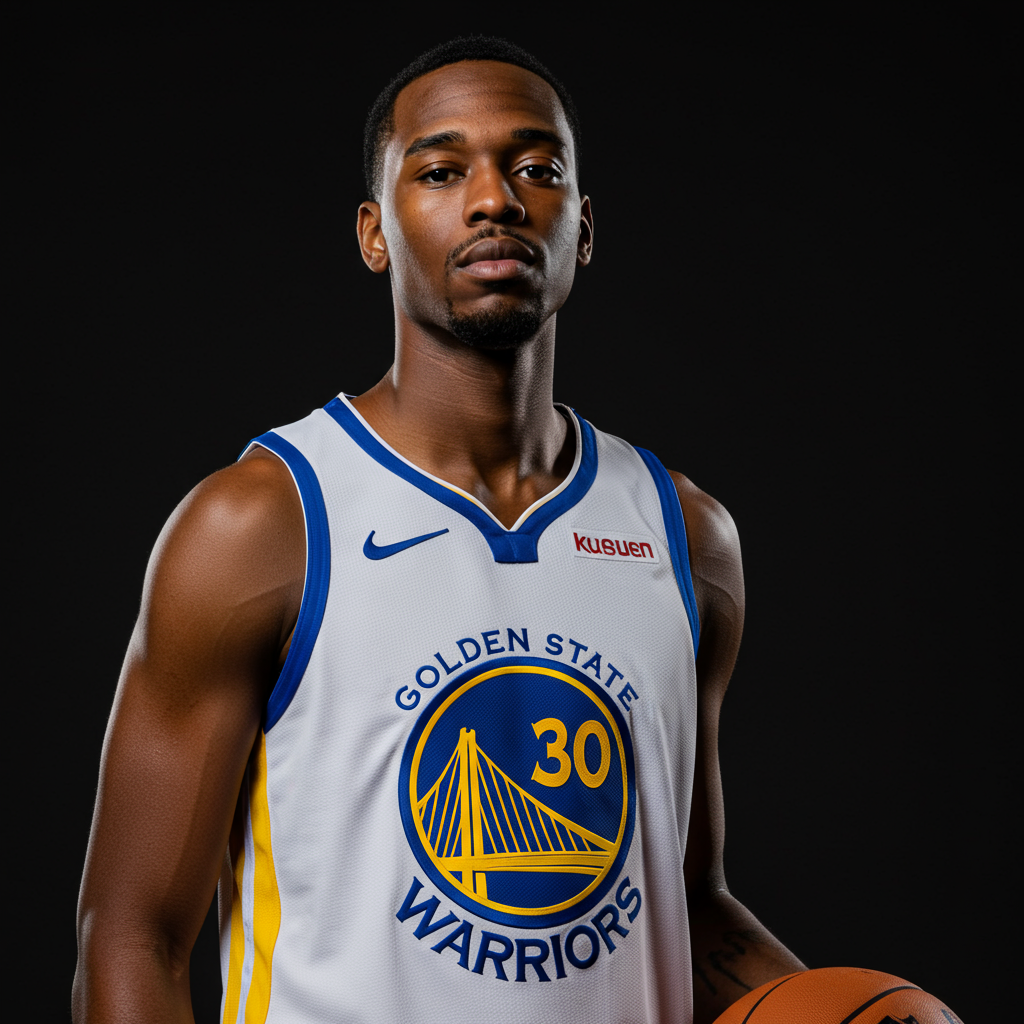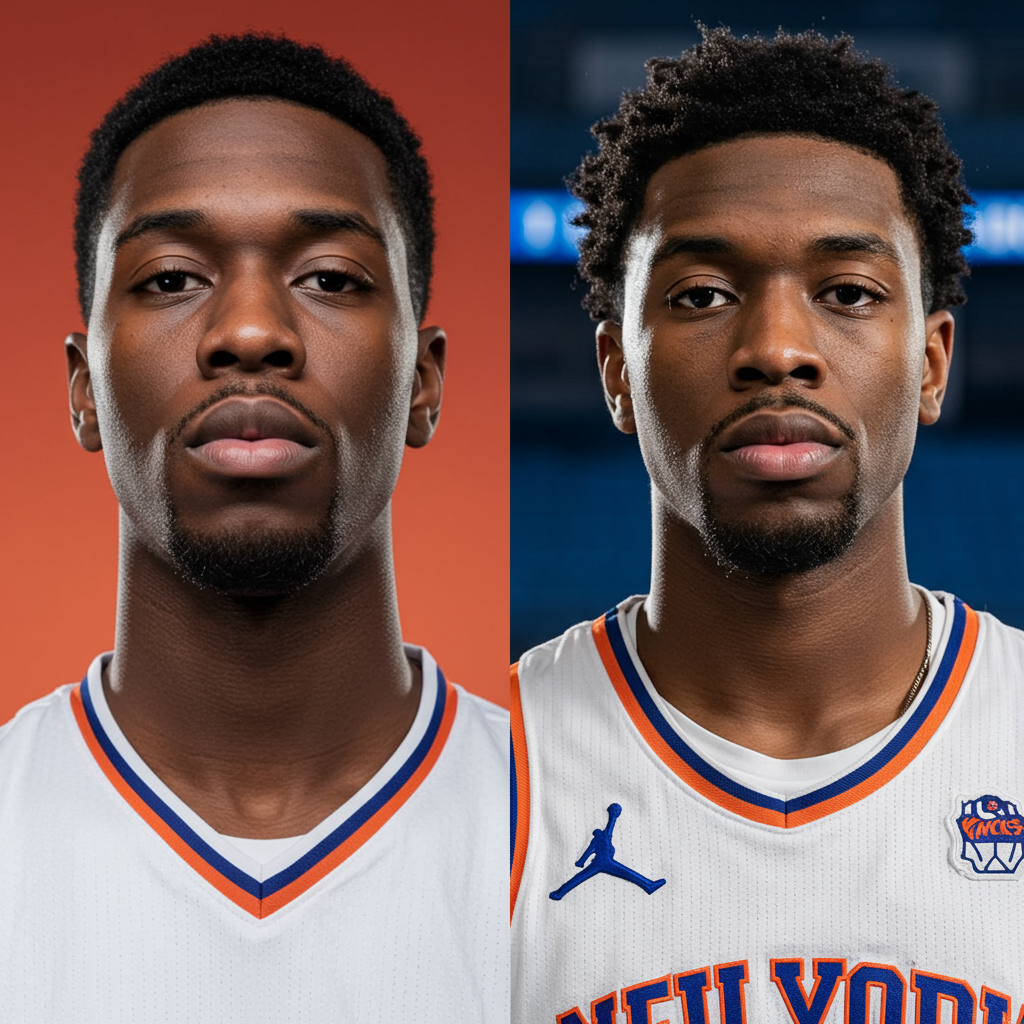Draft Day is officially here, and while the 2025 NBA Finals are now in the rearview mirror, the intrigue surrounding the league’s next wave of talent continues to swirl behind the scenes. As teams finalize their boards and engage in last-minute trade talks, ESPN draft analysts Jonathan Givony and Jeremy Woo have been tracking the latest intel, culminating in this updated two-round mock draft hours before the action begins.
The consensus appears strong at the very top, with Duke’s Cooper Flagg widely expected to land with the Dallas Mavericks at No. 1 and Rutgers’ Dylan Harper projected to join the San Antonio Spurs at No. 2. However, the picture immediately becomes less clear after those initial selections, with multiple high-profile prospects potentially shifting and trade possibilities looming large.
The two-day draft event kicks off tonight at 8 p.m. ET at Barclays Center in Brooklyn.
The Top Tier: Certainty Amidst Potential Chaos
1. Dallas Mavericks: Cooper Flagg, SF/PF, Duke
The Mavericks might have received the lottery break of a lifetime, jumping from No. 11 to secure the top spot. There remains virtually no mystery here: Dallas is locked in on Cooper Flagg. The versatile 6-foot-7¾ forward visited Dallas this week, leaving a strong impression on the front office. Set to debut at just 18, Flagg possesses a coveted two-way skill set that should allow him to make an immediate impact for a Mavericks team aiming to remain competitive in 2025-26, potentially helping fill a playmaking void early next season as Kyrie Irving recovers from an ACL tear. Regarded by some as the safest No. 1 pick in years due to his dual offensive and defensive upside, Flagg’s high floor and potential Hall of Fame ceiling make him an ideal cornerstone.
2. San Antonio Spurs: Dylan Harper, PG/SG, Rutgers
Rival teams are hearing that the Spurs are showing zero interest in trading the No. 2 pick, seemingly assured that Dylan Harper will be their guy. San Antonio is taking a patient approach to building around superstar Victor Wembanyama, viewing Harper as a foundational piece. The 19-year-old’s combination of size, shot creation, passing, and finishing makes him the type of lead guard sought after in today’s NBA. His sturdy frame is seen as well-suited for the physical demands of the playoffs. While some analysts point out potential fit concerns alongside established guards like De’Aaron Fox and Stephon Castle (both on-ball players) and the need for shooting around Wembanyama, the Spurs appear set on Harper’s high floor and potential as an offensive engine.
Despite this reported commitment, draft buzz includes a fascinating layer of intrigue: some executives believe the Spurs possess the assets (specifically the No. 2 pick) to make a run at Milwaukee Bucks superstar Giannis Antetokounmpo if he were to become available. A hypothetical Giannis-Wemby pairing is seen by some as an instant championship contender, though Antetokounmpo is not currently available. For now, the Spurs sticking and picking Harper remains the widely expected path.
Beyond the Top 2: Decisions, Slides & Trade Scenarios
3. Philadelphia 76ers: VJ Edgecombe, SG, Baylor
Holding the No. 3 pick, the Philadelphia 76ers find themselves at a crucial decision point. While VJ Edgecombe is considered the presumptive favorite if they keep the pick, Ace Bailey’s clear determination to avoid landing in this range adds complexity. Though Edgecombe reportedly appeared nervous and didn’t shoot well in a private workout, his strong impression in interviews aligns with what the Sixers front office values.
However, there is significant intel suggesting the Sixers are highly open to trading this pick. Known for their aggressive pursuit of star talent under Daryl Morey, Philly could look to trade down to acquire assets that better fit their timeline around Joel Embiid. One discussed scenario involves the New Orleans Pelicans trading up to No. 3 (potentially targeting Ace Bailey) by sending assets like the No. 7 pick, a future first-rounder, and Herb Jones to the Sixers. If the Sixers execute such a trade and move down to No. 7, they might then target a player like Khaman Maluach. But if Philadelphia holds onto No. 3, Edgecombe, with his explosive athleticism and flashes as a passer, shooter, and defender, remains the likely pick despite potential fit issues with Tyrese Maxey and Jared McCain.
4. Charlotte Hornets: Kon Knueppel, SG/SF, Duke
Should Edgecombe go off the board at No. 3 (which the Hornets are reportedly high on), Charlotte faces a choice between trading down or selecting from a pool including Knueppel, Jeremiah Fears, Ace Bailey, and Tre Johnson. Rival teams believe the Hornets will likely prioritize Knueppel’s sharpshooting, playmaking, and leadership skills, seeing him as a strong fit alongside LaMelo Ball and Brandon Miller. After taking a swing for upside last year, Knueppel is seen as a safer option who also rates well in analytics-based draft models. The question remains if they could potentially acquire him even if they trade down a few spots.
5. Utah Jazz: Jeremiah Fears, PG, Oklahoma
Under new leadership, the Jazz are looking for star power and seem willing to “take the plunge” on a talent like Jeremiah Fears. Despite being one of the youngest college players at 18, Fears had an outstanding season at Oklahoma, showcasing a combination of size, speed, shotmaking, and creation that gives him significant long-term upside. He can get anywhere on the floor to create for himself or others. The Jazz saw him in a private workout and he is reportedly drawing considerable interest from other teams like New Orleans (No. 7) and Brooklyn (No. 8) if he slips past here.
6. Washington Wizards: Ace Bailey, SG/SF, Rutgers
Ace Bailey, ranked No. 3 on ESPN’s big board, continues to generate buzz for his unique pre-draft strategy: reportedly declining workout invites from top-5 teams like Philadelphia, Charlotte, and Utah, seemingly preferring teams ranked just outside that range (Washington, New Orleans, Brooklyn). While potentially costing him millions on his first contract, Bailey’s camp is said to be confident, interpreting interest from teams outside the top 5 as assurances of landing in a more favorable situation long-term for development, role, and opportunity. This strategy, though generating negative publicity, is being watched closely by rival agents who see the potential benefits of guiding clients to optimal long-term landing spots, hoping to recoup lost money on a larger second contract if the player reaches their high ceiling as an All-Star-caliber wing. The Wizards, rebuilding patiently, could be a landing spot willing to bet on that significant upside.
Mid-First Round Movers & Shakers
7. New Orleans Pelicans: Khaman Maluach, C, Duke
If the Pelicans keep the No. 7 pick (and don’t trade up to No. 3 as discussed), Khaman Maluach appears firmly in consideration. He fits a clear need for many teams: a true center with potential as a defensive anchor. Maluach possesses significant growth potential, plays with tremendous intensity, and is lauded for his off-court intangibles. His rim protection, versatility in pick-and-roll schemes, and ability to provide vertical spacing make him an appealing long-term center prospect. There have also been some persistent rumblings about Derik Queen potentially landing here due to GM Troy Weaver’s historical connections to DMV-area prospects.
8. Brooklyn Nets: Tre Johnson, SG, Texas
While Tre Johnson was initially projected in the 4-6 range by many, a slight slip to No. 8 is a realistic scenario, though most around the league expect him to be gone by this spot. Johnson remains part of a soft consensus group in the 3-8 range and presents a strong best-available case for the Nets. Brooklyn is entering the draft with five first-round picks after recent trades (including the Kristaps Porzingis deal), and they are signaling they are unlikely to move down from No. 8, confident they will land a targeted player. The franchise seems open to rostering multiple rookies and competing for immediate playing time under a coaching staff friendly to developing young talent.
9. Toronto Raptors: Noa Essengue, PF, Ratiopharm Ulm (Germany)
Noa Essengue’s busy pre-draft schedule, including a secret workout in Toronto, highlights the Raptors’ interest. His length, mobility, and defensive versatility align with the Raptors’ organizational DNA. Though his inconsistent perimeter shooting presents challenges, his youth, tools, two-way instincts, and rapid improvement this season point to a high ceiling that is attractive in this part of the draft, potentially offering needed frontcourt depth alongside Scottie Barnes.
10. Phoenix Suns (via Houston): Carter Bryant, SF/PF, Arizona
Following their trade of Kevin Durant for Jalen Green and Dillon Brooks, the Suns moved into the No. 10 spot and are widely expected to target a defense-minded frontcourt player to complement their high-usage guards. Carter Bryant has had a positive pre-draft process and is strongly linked to this pick, as well as Toronto (No. 9) and Atlanta (No. 13). While not expected to be a primary scorer immediately, his ability to shoot from range, add value as a passer, and guard multiple positions gives him a realistic pathway to becoming a lineup fixture for Phoenix.
11. Portland Trail Blazers: Kasparas Jakucionis, PG, Illinois
Finding a confident landing spot for Kasparas Jakucionis has been tricky due to limited backcourt needs in this range and trade uncertainty, but Portland is viewed as a strong possibility. After trading Anfernee Simons and acquiring Jrue Holiday, the Blazers seem to be clearing space for Scoot Henderson and Shaedon Sharpe. This could create room to develop a younger backcourt player who can space the floor, like the unselfish, playmaking, and positionally versatile Jakucionis, who recently turned 19.
12. Chicago Bulls: Collin Murray-Boyles, PF/C, South Carolina
Collin Murray-Boyles rates historically well in various analytics models due to his passing, foul-drawing, 2-point shooting, defensive playmaking, and youth, making his range difficult to peg (Nos. 10-16). Chicago has a clear need for long-term frontcourt help, with Nikola Vucevic’s contract situation. Murray-Boyles’ toughness, unselfishness, and defensive versatility provide a high floor, making him an appealing option here, even if his lack of size and perimeter shot make him a situational fit.
13. Atlanta Hawks (via Sacramento): Egor Demin, PG/SG, BYU
Atlanta, fresh off a three-team trade acquiring Kristaps Porzingis and sending out the No. 22 pick, is unlikely to target a traditional big man here. Egor Demin, who has worked out for most teams in the top 20, is seen as a potential high-upside swing. His size and potential versatility as a perimeter playmaker stand out. The development of his jump shot is a pivotal swing skill for his projection.
14. San Antonio Spurs (via Atlanta): Joan Beringer, C, Cedevita Olimpija (Adriatic)
The Spurs could look to add frontcourt depth and another rim protector alongside Victor Wembanyama with this pick. Joan Beringer, who has grown significantly and now stands over 7 feet in shoes, has measurements similar to Jaren Jackson Jr. and Myles Turner at the same age, helping explain why he’s rated as the draft’s best shot blocker. He’s been busy with workouts across the 8-19 range.
Rest of the First Round (Picks 15-30):
- Oklahoma City Thunder (via Miami): Derik Queen, C, Maryland – Seen as the most skilled big offensively, but mixed feedback on conditioning/consistency makes his range wide (as high as #7 possible). OKC, fresh off a title and needing depth, could bet on talent here.
- Memphis Grizzlies (via Orlando): Cedric Coward, SF, Washington State/Duke – Stock has exploded. Late bloomer with impressive tools, shooting (career 38% 3P), and defensive potential. Memphis just acquired this pick.
- Minnesota Timberwolves (via Detroit): Thomas Sorber, C, Georgetown – Has risen despite injury. Physical, rim-protecting center with feel for the game. Timberwolves need frontcourt clarity this offseason.
- Washington Wizards (via Memphis): Danny Wolf, PF, Michigan – Wide range, but strong private workouts have helped stabilize stock. Intriguing size (7-foot) and playmaking ability for Washington.
- Brooklyn Nets (via Milwaukee): Asa Newell, PF/C, Georgia – Physical tools, room for growth as a shooter. Potential stretch-4 versatility. Nets have multiple picks and are expected to be active in trades, but could add a developmental player here.
- Miami Heat (via Golden State): Liam McNeeley, SG/SF, UConn – Positive workout feedback showcasing all-around offense after injury. Heat are tough to read but need shooting.
- Utah Jazz (via Minnesota): Hugo Gonzalez, SG/SF, Real Madrid (EuroLeague) – Unable to work out pre-draft due to playoffs. Impressive tools, feel for game, defensive energy make him attractive despite inconsistent playing time. Jazz need wing depth.
- Brooklyn Nets (via Atlanta): Nolan Traore, PG, Saint-Quentin (France) – Stock dropped from top-10 projections, but still offers size, handling, playmaking creativity, and upside. Worth a gamble for the Nets with their draft capital.
- New Orleans Pelicans (via Indiana): Walter Clayton Jr., PG, Florida – Dynamic shotmaker who has risen boards. Explosiveness and self-creation skills provide a path to a useful bench scorer. Pelicans could use backcourt shooting.
- Oklahoma City Thunder (via LA Clippers): Will Riley, SG/SF, Illinois – High upside swing with size, offensive feel, and shooting potential. Likely needs physical strength and defensive improvement, possibly destined for G League. OKC has a crowded roster and is open to trading this pick.
- Orlando Magic (via Denver): Jase Richardson, PG/SG, Michigan State – Highest-ranked player (No. 18 ESPN) not invited to Green Room, adding uncertainty. Scoring efficiency, defensive intensity, and off-ball ability appeal to Magic needing shooting/backcourt depth.
- Brooklyn Nets (via New York): Nique Clifford, SG, Colorado State – Plug-and-play rotation option potential due to versatility and strong senior season. Interest in the teens, but realistic landing spot in the 20s for Brooklyn.
- Brooklyn Nets (via Houston): Rasheer Fleming, PF, Saint Joseph’s – Physical tools and improving 3-point shot make him intriguing despite not gaining significant pre-draft momentum. Untapped potential for the Nets’ collection of picks.
- Boston Celtics: Maxime Raynaud, PF/C, Stanford – Played into late first-round consideration with size and flashes of offensive skill, including floor spacing. Celtics offloaded salary and can focus on long-term depth needs here.
- Phoenix Suns (via Cleveland): Ryan Kalkbrenner, C, Creighton – Four-time Big East DPOY offers needed interior presence and shot-blocking for the Suns, whose frontcourt depth was impacted by the Durant trade.
- LA Clippers (via Oklahoma City): Noah Penda, SF/PF, Le Mans (France) – Versatile forward who can play multiple positions and defend several spots. Needs perimeter shooting improvement but offers feel, skill, and size as selling points for a Clippers team looking for bench value.
- Minnesota Timberwolves (via Utah): Ben Saraf, PG/SG, Ratiopharm Ulm (Germany)
- Boston Celtics (via Washington): Drake Powell, SG/SF, North Carolina
- Charlotte Hornets: Yanic Konan Niederhauser, C, Penn State, junior
- Charlotte Hornets (via New Orleans): Tyrese Proctor, PG, Duke, junior
- Philadelphia 76ers: Adou Thiero, PF, Arkansas
- Brooklyn Nets: Yang Hansen, C, Qingdao (China)
- Detroit Pistons (via Toronto): Chaz Lanier, SG, Tennessee, super senior
- San Antonio Spurs: Jamir Watkins, SG/SF, Florida State, senior
- Toronto Raptors (via Portland): John Tonje, SF, Wisconsin, super senior
- New Orleans Pelicans (via Washington): Bogoljub Markovic, PF/C, Mega Superbet (Adriatic)
- Golden State Warriors (via Miami): Rocco Zikarsky, C, Brisbane (Australia)
- Sacramento Kings (via Chicago): Koby Brea, SG/SF, Kentucky, super senior
- Utah Jazz (via Dallas): Sion James, SF, Duke, super senior
- Oklahoma City Thunder (via Atlanta): Johni Broome, C, Auburn, super senior
- Chicago Bulls (via Sacramento): Alex Toohey, SF/PF, Sydney (Australia)
- Orlando Magic: Kam Jones, PG/SG, Marquette, senior
- Milwaukee Bucks (via Detroit): Javon Small, PG, West Virginia, senior
- Memphis Grizzlies (via Golden State): Micah Peavy, SG/SF, Georgetown, senior
- Cleveland Cavaliers (via Milwaukee): Vladislav Goldin, C, Michigan, super senior
- New York Knicks (via Memphis): Lachlan Olbrich, PF/C, Illawarra
- LA Clippers (via Minnesota): Eric Dixon, PF, Villanova, super senior
- Phoenix Suns (via Denver): Alijah Martin, SG, Florida, senior
- Utah Jazz (via LA Clippers): Amari Williams, C, Kentucky, senior
- Indiana Pacers: Dink Pate, SG/SF, Mexico City (G League)
- Los Angeles Lakers: Viktor Lakhin, C, Clemson, super senior
- Memphis Grizzlies (via Houston): Hunter Sallis, SG, Wake Forest, senior
- Orlando Magic (via Boston): Kobe Sanders, SG/SF, Nevada, senior
- Cleveland Cavaliers: Saliou Niang, SG/SF, Trento (Italy)
- Houston Rockets (via Oklahoma City): Ryan Nembhard, PG, Gonzaga, senior
Second Round: Value Picks & Depth
The second round offers teams opportunities to find hidden gems, depth pieces, and potential two-way contract players. Several prospects in this range possess standout skills that could translate well to the NBA level.
Kentucky Wildcats duo Koby Brea and Amari Williams are notable names expected to hear their names called. Brea is lauded by some experts as potentially the best shooter in the entire draft class, boasting exceptional volume and efficiency (48% from three over the past two seasons). His 6-foot-7 size for a shooter is highly valued, and his ability to shoot dynamically adds versatility. While he needs to improve his defense and handle attacking closeouts, his elite shooting provides a clear pathway to an NBA role, potentially allowing him to climb into the early 30s.
Amari Williams, a 7-foot, 260-pound big man with a 7-foot-5 wingspan, offers a different but equally intriguing profile. While his lack of an outside shot likely keeps him out of the first round, he possesses rare playmaking skills and capable ball-handling for his size, making him a high-level “floor spacer” in a different sense. Williams is also highlighted as an elite rebounder and a solid all-around, physically imposing defender. He projects as a potential frontcourt depth piece, leveraging his size, length, and rim protection. Improving his defensive versatility outside the paint and developing more diverse offensive moves beyond passing will be key to solidifying a long-term NBA career, potentially starting on a Two-Way contract.
Here is the complete second-round mock draft:
With Flagg and Harper seemingly locked in, the real drama begins at No. 3, where the Sixers could spark significant movement. Factor in players strategically maneuvering for ideal landing spots, recent trades reshaping team needs, and multiple teams holding a wealth of picks, and draft night is set to be as unpredictable and exciting as ever.



